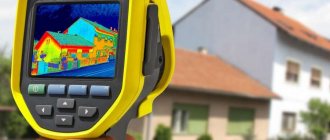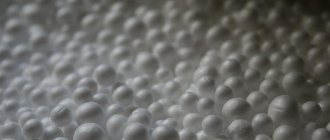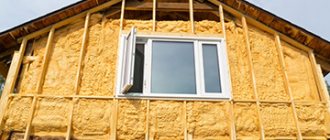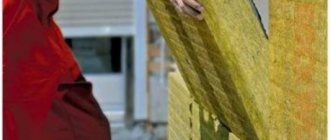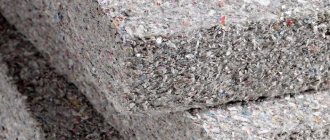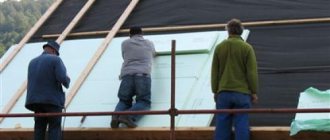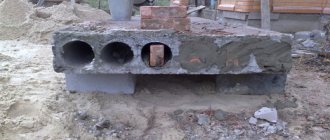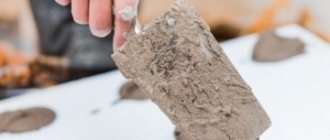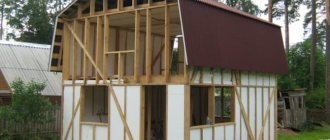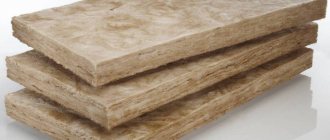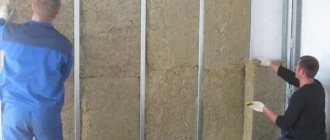Characteristics of foam plastic
Polystyrene foam is a material consisting of foamed cellular plastic masses. Due to the high gas content, it has low density and low specific gravity. Common types in everyday life are: non-pressed and extruded polystyrene foam.
Advantages and disadvantages
The advantages include:
- high thermal insulation performance;
- low coefficient of moisture permeability;
- good sound and noise permeability;
- light weight;
- Suitable for work outside and inside the house.
There are a number of disadvantages:
- Susceptible to destruction from exposure to chemical liquids. Therefore, when finishing work, this must be taken into account.
- When burned and heated, toxic substances are released. It is worth choosing carefully when finishing interior spaces and facades.
- Subject to mechanical stress.
- Vapor permeable. Drops settle inside and, when frozen, destroy the material.
In construction, it is used as a heat-insulating material for insulating private houses. It has found its application in the creation of structural and decorative parts - arches, false fireplaces.
Video: choosing foam
Kinds
Based on their structural structure and method of application, polystyrene foam is divided into types. There are:
- tile expanded polystyrene (PPT);
- pressless self-extinguishing foam plastic (PSB-S);
- penoplex - improved foam plastic;
- penofol - rolled thermal insulation material;
- liquid – urea-formaldehyde polystyrene foam.
All types are classified according to the principle of use and application specification.
penoplast
penoplast-psb-s
penopleks
penofol
penoizol
Density and markings
To distinguish types of polystyrene foam, markings with letters and numbers are used. For pressed foam - PS, for non-pressed foam - PSB. The numbers following the letters indicate the density of the material.
The main brands of pressless foam:
- PSB-S-15. Due to its low density (15 kg/m³), the material is used in cases where there are no special requirements for rigidity.
- PSB-S-25. A common thermal insulator for building insulation. High density, long service life.
- PSB-S-35. Thermal insulation of foundation, pipeline.
- PSB-S-50. Highest density. Mainly used in the construction of industrial enterprises.
Thermal conductivity of the material and level of fire resistance
The thermal conductivity of a material directly depends on its density. The higher the density, the less heat loss. Let's look at this ratio in the table.
| Density indicators, kg/m3 | Thermal conductivity, W/m3 |
| 10 | 0,044 |
| 15 | 0,038 |
| 20 | 0,035 |
| 25 | 0,034 |
| 30 | 0,033 |
| 35 | 0,032 |
Watch the video: testing expanded polystyrene in practice.
The fire resistance of a material can be determined by its marking. PSB-S foam contains fire retardants, so the material does not support combustion and will not ignite. The letter C in the marking means self-extinguishing.
Polystyrene foam as insulation: pros and cons
In Russia it is popular to use mineral wool as insulation. But those who have made the choice to insulate the frame in favor of polystyrene foam note a number of advantages that mineral wool cannot boast of.
Strengths:
- Availability. The most obvious advantage. Polystyrene foam is sold in all sorts of variations, sizes, and board thicknesses. The cost of producing polystyrene foam is not associated with large expenses - this affects its price for the final consumer.
- Economical. With the same thermal conductivity characteristics of polystyrene foam, you will need 3 times less than the popular mineral wool.
- Ease of installation. Compared to the mentioned mineral wool, polystyrene foam is convenient to install both inside and outside. Min. cotton wool spills onto the face; when working with it, you need gloves, a respirator and other protective equipment, otherwise you can get irritation and an allergic reaction. More details about the installation technology are described below.
Sheathing the walls with foam plastic inside is a good option for both insulation and solving the issue of sound insulation
- Water resistance. Foam plastic can be used to insulate floors and foundations – structures exposed to aggressive water. The impact that moisture has on this material is minimal. With minimal waterproofing and vapor barrier work done correctly, the material becomes the best way to insulate a frame house.
- Noise insulation. The foam structure of the material allows you to reliably block noise coming from the street.
- One of the lowest thermal conductivity values. Thanks to this property, a house sheathed with foam plastic quickly gains temperature and maintains it for a long time.
- Does not shrink. Natural insulation and some synthetic ones can change over time due to temperature changes and environmental humidity. When all installation technologies are carried out, foam plastic boards do not shrink and remain in place.
By the way. Foam plastic cannot be called natural. But it does not contain harmful substances that harm the environment and human health. The material has nothing to do with styrene! After the end of its service life, it can be easily recycled and disposed of.
The nuances of using polystyrene foam as insulation in a frame house:
- Compliance with fire safety rules. The composition of modern raw materials for the production of foamed polystyrene includes additives that increase its resistance to fire. However, to prevent fire, it should be protected with a fire-resistant coating.
- Protection of material from rodents. Mice love to gnaw passages and make holes in it. On this side, polystyrene foam, due to its foamed structure, is an ideal material for rodents. The task of the house owners is to block their access to the polystyrene foam by covering the heat insulator with harder materials (chipboard, fibreboard, OSB).
- Compliance with technology. Carrying out thermal insulation work involves careful preparation of the surface for laying foam boards and post-processing of seams and joints. Improper installation of material can result in serious damage to the structure. Between the foam slabs, in the literal sense of the word, the wind will “walk.”
- Ventilation. Foam materials, installed correctly, will turn your home into a real thermos. Therefore, even at the design stage of a building, the ventilation system should be carefully considered.
From these points it is clear that everything depends on taking into account all the subtleties of the thermal insulation process.
Mixtures and fasteners used for foam insulation
Construction markets offer various mixtures for foam fastening. Main types of fastening:
- adhesive mortar based on cement mixtures;
- plastic dowels.
smes
dyubelya-52
Popular types of mixtures:
- Mapei.
- Gr
The mixture can be applied in several ways, it all depends on the surface to be insulated. Main types of application:
- continuous – with differences on the insulated surface of up to 5 mm;
- applying stripes over the entire area;
- point, up to 5 points over the entire surface (differences over 10 mm).
To secure the slab, secure it with plastic dowels.
Nuances of OSB foam sheathing from a professional
The technology of finishing the frame with foam plastic and plaster on top came to us from the USA in 1993. Since then it has been successfully used.
Here is a video with an example of such a facade:
For SFTK facades, the best specialist on YouTube is Denis Nikolsky. He has been working on just such facades for 26 years. Watch other videos on his channel to understand the level. He posts free lessons and answers all questions in the comments to the videos, for which he is honored and respected.
The video shows a house made of SIP panels. Foam plastic acts as a damper, the basis for a wet facade, for the base reinforcing layer. The optimal thickness is 5cm. The minimum thickness of foam in the USA for such facades is 2.5 cm.
With minimal PPS thicknesses, we do not use additional fixation with dowels, as wet spots may appear.
Insulation of frame houses from the outside
Due to its thermal insulation, noise-absorbing and waterproof properties, foam plastic is suitable for insulating frame houses from the outside.
Insulation of the facade with penoplex
When insulating the frame externally, it is better to use 2 layers of foam boards, which need to be glued together and attached to the outer wall with plastic dowels. To glue the slabs to the facade, it is recommended to use mounting foam designed for penoplex.
Components of the interior and exterior finishing materials of the frame
Facade insulation process:
- Using a mounting gun, apply glue around the perimeter of the insulating board at a distance of 1-3 cm from the edge.
- For additional hold, add a bead of glue diagonally or along the slab.
- Wait 1-2 minutes and press the slab firmly against the facade with a shift of 1-2 cm to ensure even distribution of the glue.
- To ensure secure fastening, secure the plates with disc fasteners with self-tapping screws (4-5 screws per plate).
- Treat the surface of the penoplex with sandpaper, cover the entire area with a cement-based adhesive and lay a fiberglass mesh on it.
- When the surface dries, it is plastered.
For finishing, you can use regular plastic siding or more expensive types of facade finishing.
Thermal insulation with penoplex compares favorably with mineral insulation and foam plastics; the high thermal insulation properties of the material make it indispensable in the construction and repair of structures of any complexity.
Pay attention to the video: stages of insulating a frame with penoplex.
Wet method
The wet method consists of the following steps:
- Clean the outer walls from dust, dirt, nails.
- Level the walls. The insulation must fit tightly to the surface.
- Treat the walls with primer.
- Using a building level, install vertical plumbs from the cords. This will help secure the foam boards evenly without distortion.
- Glue the insulation to the wall.
- Seal the gaps between the pieces of polystyrene foam. You can use liquid foam instead of polyurethane foam.
- Secure with dowels, preferably plastic ones.
- Prime the entire surface with the adhesive solution.
- Cover with fiberglass reinforced mesh.
- To protect from external influences, cover with a layer of putty.
To provide moisture protection, install waterproofing between the foam and the wall.
Mounted method
With the mounted method, the sequence of work looks like this:
- Mount the frame on the wall.
- Cover the surface with waterproofing. It can be of two types - pasting and painting. In the first case, roll material is attached. In the second, apply bitumen to the primed wall.
- Place insulation boards between the frame posts. Secure with construction adhesive or mounting dowels.
- Sew up the frame with finishing panels.
For thermal insulation on the outside of a building, extruded polystyrene foam is usually used. It is more durable and frost-resistant.
Find out more about insulation and finishing of the facade of a wooden house on our website.
Roof
Insulating the roof of a building is a labor-intensive process.
Sequence of arrangement of materials for roof insulation
Stages of work:
- installation of counter-lattice;
- vapor barrier layer;
- insulation;
- waterproofing layer;
- covering with decorative materials.
To improve thermal insulation, the foam layer can be made double.
You can learn about basement insulation in a private house from the article at the link.
Alternative materials: comparison with foam
To insulate residential buildings and outbuildings, you can use alternative finishing materials based on synthetic or mineral bases. Thermal insulators are superior to foam plastic in terms of performance characteristics, have increased resistance to a humid environment, but are 2-4 times more expensive, which should be taken into account when choosing a material.
Penoplex
This insulation has a monolithic structure and increased resistance to moisture. The material has a vapor permeability that is 5-7 times lower than granulated foam, so forced ventilation is required in the house. The finish has a premium price (30-50% more than standard granular material) and is designed to last between 20-25 years. In addition to sheet material, there is liquid penoplex in aerosol cans.
Penoplex is one of the most effective thermal insulation materials.
Expanded polystyrene
Extruded polystyrene foam has a monolithic structure without granules and air pores, which allows reducing thermal conductivity to 0.028 W/m*K. The material can withstand increased mechanical loads and does not absorb moisture even when under water for several days. The disadvantages are low resistance to external thermal influences and open fire, as well as an increased price (2 times more than standard foam).
Expanded polystyrene is successfully used to solve various construction problems.
Minvata
Mineral wool allows atmospheric air to pass through, providing natural ventilation of the room, and is not destroyed by high temperatures and open fire. The material does not emit toxic substances, but during operation it absorbs water with loss of its original characteristics.
Mineral wool is a fibrous thermal insulation material.
To ensure maximum service life (up to 50 years), it is necessary to protect the mineral wool layer from moisture.
Basalt slab
Basalt slab has a thermal conductivity coefficient at the level of foam plastic (0.037 W/m*K and from 0.036 W/m*K, respectively), and is an environmentally friendly material that does not emit harmful substances into the atmosphere. The material is breathable and does not ignite when exposed to open fire, but absorbs rainwater and moisture from the air.
The service life of thermal insulation reaches 50 years, which is 2 times longer than the durability of foam plastic. The disadvantage is the price increased by 2-3 times, which leads to an increase in the cost of finishing the house.
Basalt slab is a natural and inexpensive heat insulator.
Wet facade cake on foam plastic
This recipe has been proven over two decades of practice.
- OSB 12mm minimum
- glue PPS16f foam onto the adhesive foam (according to the new GOST PSB-S 25f is now labeled PPS16f)
- additionally secure with dowels
- All joints are covered with high-quality foam (with high secondary expansion)
- base reinforcing layer, which is done like this:
- apply Ceresit ST-85 glue,
- we embed the facade fiberglass mesh into the layer of glue,
- corners, scarves are sunk in
- and then reupholster with a thin layer to hide the mesh structure
- the result is 3-4mm
- quartz primer CT-16 (preferably tinted to match the color of the decorative plaster so that it doesn’t fade later) is applied with brushes to transfer sand to the wall and is not diluted
- decorative plaster
There is no need for a gap under the OSB if there is a good vapor barrier under the interior trim.
If the OSB has traces of mold, then we use standard wood bleaches.
A quartz primer is needed before applying acrylic decorative. The facade can be left in a quartz primer for 5-8 years. So such a facade makes it possible to do it in stages, if time or finances are difficult.
The mesh is used by Bautex. You shouldn't skimp on it.
Denis uses exclusively Biysk dowels - façade dowel DS-1 "Biysk" (Biysk fiberglass plant).
